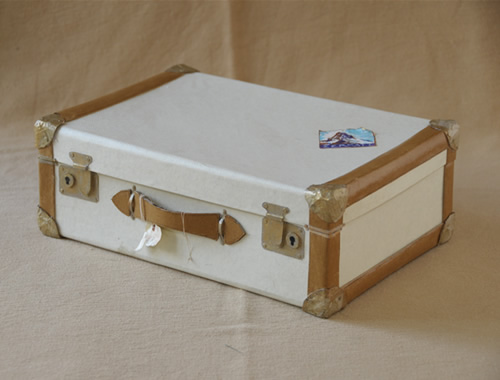Annie‘s diverse artistic background and spirituality ultimately lead her to create Eco-Urns, her UK based biodegradable urn business. Today, Annie creates thoughtful, unique and sustainable urns ranging from simple ceramic to highly personalized designs. Read her responses to all our eco-urn questions, below!

Annie hard at work in her studio
Aurora: How and why did you begin making eco-urns?
Annie: Several years ago, I was asked if I could make a container that could be buried but would not pollute the soil. It was for a Buddhist funeral ritual. I was approached to create the urn because I have done a large body of artwork in a very wide range of techniques and materials. I tend to be offered work which doesn’t sit neatly in any particular category or style. In this case, it was also because I am a Buddhist practitioner. I ended up making a lovely biodegradable stupa out of card.
I felt that it was an honor to contribute to a funeral like this. It was deeply moving to realize the urn had added a great deal to the ritual and was very much appreciated. Over a period of time, the idea of specializing in this service gradually developed.
Aurora: What is the decomposition time for your urns?
Annie: It is approximately three or four months for papier mache urns, although timing depends to some extent on conditions such as the moisture content of the soil. Air-dried clay degrades quite quickly in water.
Aurora: Besides being biodegradable, what else makes your urns ecological?
Annie: I have gone to great lengths to ensure that the urns are as fully biodegradable as possible. Paper and clay are biodegradable by nature. The wallpaper paste I use is fungicide and VOC free. My paints are casein (milk powder) based. Any additional materials are organic, including decorative supplies.
My urns are also ecological in that, where possible, I recycle materials. I particularly like to reuse packaging paper. It is often interestingly colored, speckled or textured. I avoid printing paper and ink, which is generally not eco-friendly. Organic string is delightful, although not used too often now in packaging.
As my urns are handmade, they are seriously low-tech. No energy is used (except mine, of course)!

Annie's design for her mother
Aurora: Do you have a personal favorite out of your urn designs?
Annie: I enjoy all the urns. Each one is special to me, from the simplest to the most elaborate. But so far, the suitcase is the one I loved the most. I made it for my mother, who was an intrepid and enthusiastic traveler; so I made her a little suitcase urn, typical of the period when she was in her prime. It was accurate in every detail, but made entirely from paper and card, with a tiny bit of paint for the labels. It was a lovely thing to be able to do… the suitcase is an appropriate symbol on many levels.
Aurora: That’s really wonderful. What suggestions do you have for someone who wants a personalized vessel, but isn’t sure what would best express their loved one?
Annie: I would ask them to talk to me, along with close friends and family. Often, through communication, it becomes apparent that people do know what best expresses their loved one. For me, to be trusted with this communication is a precious part of what I do.
Aurora: As an artist, how do you feel about creating such ephemeral designs?
Annie: It is profoundly satisfying to know that what I create is overtly impermanent, a stage in a process, part of the cycle of nature.
Aurora: Thank you so much, Annie!

 An Interview with Annie Leigh
An Interview with Annie Leigh


 Recovering Cremation Remains After the Los Angeles Fires
Recovering Cremation Remains After the Los Angeles Fires
 “As Tears Go By” by Marianne Faithfull
“As Tears Go By” by Marianne Faithfull
 “The Sea” by John Banville
“The Sea” by John Banville














